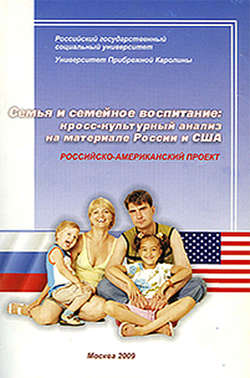Читать книгу Семья и семейное воспитание: кросс-культурный анализ на материале России и США - Коллектив авторов - Страница 26
Что означает термин «Семья»? Точка зрения государства всеобщего благосостояния – США
Литература
Оглавление1. Bramlett, Matthew and William Mosher (2001). “First Marriage Dissolution, Divorce, and Remarriage: United States”. Advance Data Series No. 323. U.S. Centers for Disease Control (www.cdc.gov).
2. Brooks-Gunn, Jeanne (1997). Neighborhood Poverty: Context and Consequences for Children. New York: Russell Sage Foundation.
3. Burstein, Paul, R. Marie Bricher, and Rachel L. Einwoher. 1995. “Policy Alternatives and Political Change: Work, Family, and Gender on the Congressional Agenda, 1945–1990.” American Sociological Review 60(1): 67–83.
4. Child Trends Social Science Research (www.childtrends.org).
5. Egge been, David J. and Daniel Lichter (1991). “Race, Family Structure, and Changing Poverty among American Children”. American Sociological Review 56(6): 801–817.
6. Gals ter, George (2000). “The Impacts of Supportive Housing on Neighborhoods and Neighbors”. Urban Institute Report. Washington D.C.: U.S. Department of Housing and Urban Development.
7. Hill, Martha (1995). “When Is a Family a Family? Evidence from Survey Data and Implications for Family Policy”. Journal of Family and Economic Issues 16(l):35–64.
8. Mather, Mark and Kerri Rivers (2006). “The Concentration of Negative Child Outcomes in Low-Income Neighborhoods”. Annie E. Casey Foundation Population Reference Bureau (www.prb.org/pdf06/NegChildOutcomes_ Neighborhoods.pdf).
9. Monroe, Pamela (1995). “Family Policy Advocacy: Putting Knowledge to Work”. Family Relations 44(4):425M37.
10. Murray, Charles. 1984. Losing Ground: American Social Policy, 1950–1980, New York: Basic Books.
11. Oliker, Stacey (1994). “Does Workfare Work? Evaluation Research and Workfare Policy”. Social Problems 41 (2): 195–213.
12. Pearce, Diana (1978). “The Feminization of Poverty: Women, Work, and Welfare”, Urban and Social Change Review, vol 30.
13. Piven, Frances Fox and Richard Cloward (1987). “The Contemporary Relief Debate”. The Mean Season: The Attack on the Welfare State, ed. Fred Block. New York: Pantheon Books.
14. Rayman, Paula and Ann Bookman (1999). “Creating a Research and Public Policy Agenda for Work, Family, and Community”. The Evolving World of Work and Family: New Stakeholders, New Voices. Annals of the American Academy of Political and Social Science.
15. Sapiro, Virginia (1990). “The Gender Basis of American Social Policy”. Women, the State, and Welfare, ed. Linda Gordon. Madison: University of Wisconsin Press.
16. Schram, Sanford (1992). “Post-Positivistic Policy Analysis & the Family Support Act of 1988: Symbols at the Expense of Substance”. Polity 24(4): 633–655.
17. Shonkoff Jack P and Deborah Phillips (2000). From Neurons to Neighborhoods: The Science of Early Childhood Development. Washington, DC: National Academy Press.
18. Smith, Daniel Scott (1993). “The Curious History of Theorizing about the Histoiy of the Western Nuclear Family.” Social Science Histoiy 17(3) 325-33.
19. Tankersley, Holley (2002). “Who are the People in Your Neighborhood? Measuring the Effects of Relative Affluence on Educational Attainment”. Catalouged Master’s thesis. Washington, D.C.: Georgetown University (www. georgetown. edu/library).
20. United States Bureau of the Census (2007) (www.census.gov). Family and Household Statistics.
21. United States House of Representatives (2007). Historical Legislation Information (http://clerk.house.gov/legislative/legvotes.html).
22. United States Senate (2007). Legislation and Records. (http://www.senate.gov/pagelayout/legislative/g_three_sections_with_teasers/legislative_home.htm).
23. Wilson, William Julius (1987). The Truly Disadvantaged: The Inner City, the Underclass, and Public Policy. Chicago: University of Chicago Press.
Перевод с английского Э.А. Алескеровой
